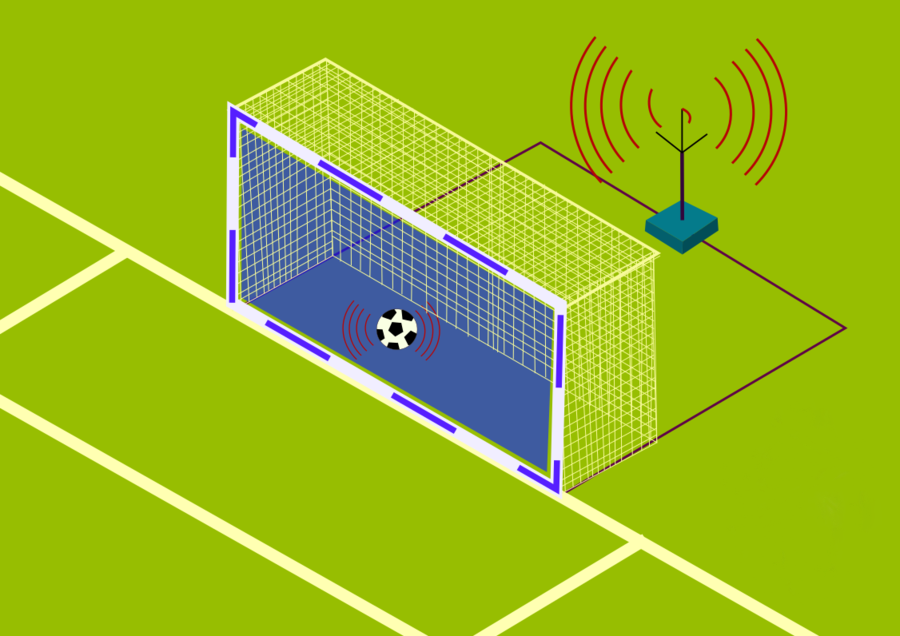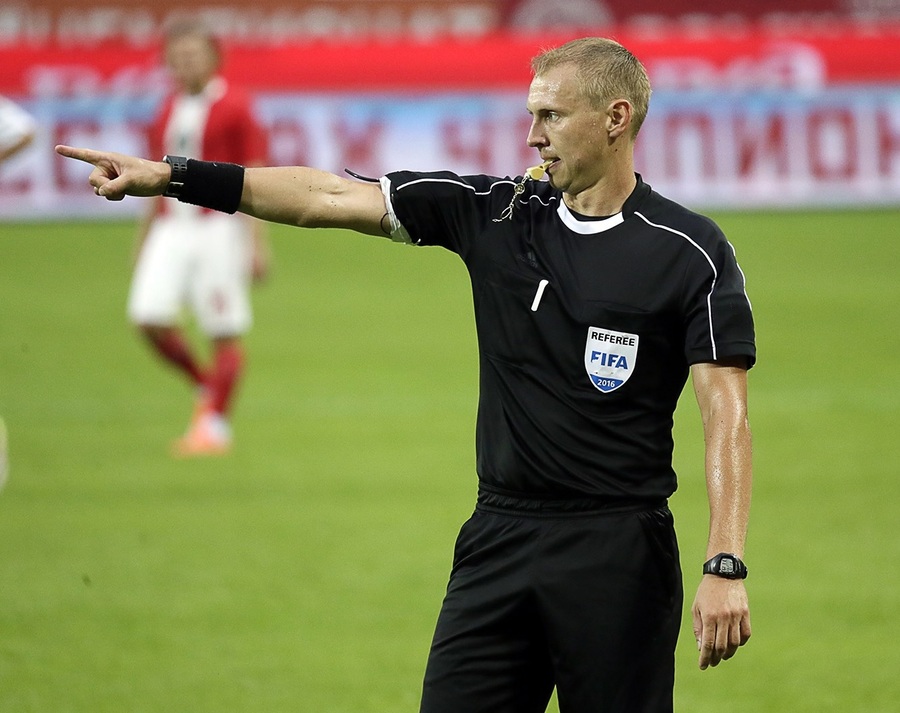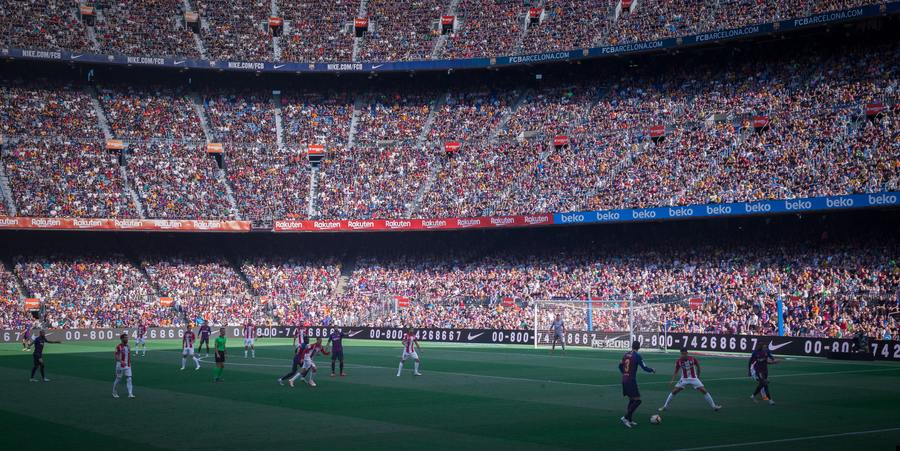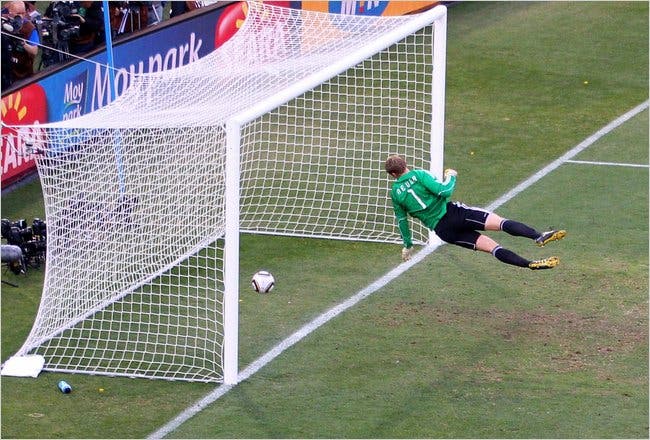The Goal Line Technology or Goal Decision System is a moviola system that reproduces the trajectory of the ball and its path. The basic principle is that of triangulation: using images recorded by fourteen cameras located at different points in the field, the system controls the recorded videos and, based on predefined models of the field and the rules of football, determines whether the ball has entered completely or not.

Cameras record at a rate of 340 frames per second. If the ball completely crosses the line, within a second a message is sent to the referee, visible on the watch screen, with the word "GOAL". No one in the audience will then be able to see the images of the system. Background. The company that produces the system is the British Hawk-Eye Innovations Ltd, owned by the multinational Sony. According to Paul Hawkins, the inventor of the system, its margin of error is four millimeters, well below the thirty millimeter margin set by FIFA in its regulation.1 The IFAB (International Football Association Board), which approves changes to regulations in football and enforce them to all latitudes and all categories, approved the GoalRef and Hawk-Eye in July 2012. The GoalRef is a system that was put in Denmark at the beginning of this decade and is based on magnetic induction. It was developed mainly thanks to the International Federation of Handball and Fraunhofer-Gesellschaft, an applied research company, with more than 18,000 researchers and a budget of almost two billion euros per year. It was tested first in the Danish top league and then was also approved by Fifa.2
The hawk's eye uses four cameras placed in different positions that follow the path of the ball
As was the Hawk-Eye, which has been used in Tennis and Cricket for 10 years. The hawk's eye uses four cameras placed in different positions that follow the path of the ball and manage through the pixels of the image to reconstruct the precise point where it is in each fraction of a second. A system that in tennis has certainly been a good success, although the demand for use by the players is limited by regulation. Both of these techniques were used in the 2012 Club World Cup, but were later scrapped for the 2013 Confederations Cup.When it was decided to tack on the Goalcontrol 4D.3 Fourteen cameras follow the game and monitor the position of the ball. And the role of the referee is also simplified, which thanks to a sensor receives a signal when the ball has crossed the line. When this does not happen, it does not receive any stimulus and can therefore consider the whole thing to be regular. A system that, moreover, was also considered cheaper by Fifa which then adopted it at the Confederations and the 2014 World Cup. 4

According to the online magazine Wired, goal line technology could be even cheaper than the current goal referees who cost Figc around 800,000 euros a year, a total of two and a half million euros until the end of the 2014/2015 season.5 The costs for the installation of goal line technology will be divided between Figc and the clubs, while the maintenance of the facilities will weigh all over the seconds. Cost of the operation, for clubs, 175 thousand euros to mount sensors and cameras (one-off) plus about 2500 euros per game (47500 euros per league). "Figc has put the subject of the new technology on the calendar with the next season (2015/16 ndr) – explained President Carlo Tavecchio in December – Who will possibly have to bear the costs? Companies. The goal umpires? Until June 30th there will be, then we will decide whether to keep them or not."6 Clear, concrete words that have hinted at the imminent change of course of the federal leadership. A breakthrough that would have two huge advantages. The first of a purely sporting character: to avoid episodes, controversies, debates, references to conspiracy like the one that took place in Udine on the last day. In that case for the additional Maresca the header of the Roma defender was not goal, for the referee Guida yes. A matter of perspective, even if on the goal line there was the first and not the second. The second, much more important in a period not economically prosperous for our football, economic: an obvious savings in the long term.

Despite this, the use of the goal line technology system has raised numerous debates and controversies about its application; the biggest criticism of the system is that it takes away the human element in a goal decision and takes away an important responsibility of a referee. While a referee, with the help of his linesmen, is expected to cover all 100+ yards of grass and get every possible decision correct, the element of human decision is a crucial part of the game.7 There are widespread fears that the introduction of the technology could undermine the concept that the referee's decision is final and some skeptics believe that players will take advantage of the technology and begin to challenge all other calls made by the referees. The former FIFA President Sepp Blatter supports the human element in refereeing a match, "Other sports regularly change the laws of the game to react to the new technology. . . We don't do it and this makes the fascination and the popularity of football.”8
There have also been complaints from players, Clarence Seedorf and Hugo Ibarra, who have tested the technology regarding the difficulty in controlling the new ball and its trajectory.
What appears to be another concern of Blatter, is the potential the inaccuracy of the technology, whether it can detect if the whole of the ball has crossed the line and the delay in transmitting data. There have also been complaints from players, Clarence Seedorf and Hugo Ibarra, who have tested the technology regarding the difficulty in controlling the new ball and its trajectory. A final argument endorsed by FIFA's president against the introduction of GLT is that the fans love the debate. He believes long after the game will the fans continue to discuss the issue. So, as long as fans are talking about football, whether it be in a positive or negative way, it is good for the sport.
Here we look at controversial incidents which would have been cleared up quickly with goal line technology. In Sulley Muntari, AC Milan vs Juventus, 2012 AC Milan were already leading 1-0 through Antonio Nocerino’s deflected strike in the 14th minute a year ago when Sulley Muntari inadvertently wrote his name into Serie A history. Juventus goalkeeper Gianluigi Buffon made a tremendous save to parry one header, but the fall bounced into the path of the Ghanaian who headed past the Italy international and began his celebrations. However, match official Paolo Tagliavento waved play on after Buffon clawed the ball back from behind his goal line. To make matters worse for Milan, Alessandro Matri equalised for Juventus to leave the San Siro side one point ahead in the Serie A table. Juventus won the Scudetto last season, four points ahead of AC Milan.9

And for Frank Lampard, England vs. Germany, 2010, Frank Lampard's "goal" was the catalyst for change after FIFA president Sepp Blatter apologised for the mistake by match officials. England were in the ascendancy after Matthew Upson made it 2-1 following a torrid opening period in the last-16 tie against Germany in Bloemfontein which saw them losing by two goals. Then, in the 38th minute, Lampard floated a ball over the head of Germany goalkeeper Manuel Neuer which struck the underside of the crossbar and came down past the keeper. But match referee Jorge Larrionda and his assistant Mauricio Espinosa failed to see the ball had crossed the line. It is difficult to argue with a deserved final result of 4-1 to Germany after England's poor second-half display, but it could have been different for Fabio Capello's side with the impetus of an equalizer.10
